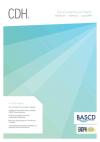Community Dental Health

- Cover Date:
- June 2019
- Print ISSN:
- 0265 539X
- Electronic ISSN:
- 2515-1746
- Vol:
- 36
- Issue:
- 2
Editorial - How soon is soon enough? The challenge of implementing behaviours conducive to good oral health in at-risk infants and toddlers
10.1922/CDH_ChestnuttJune19editorial02
This commentary is about one of the last great challenges
facing dental public health. It is a problem I will discuss in
a United Kingdom context, but the issues will, I am sure,
be of relevance to all readers of this Journal wherever they
practice. It is a problem that I spent many hours trying to
address when I was in the early stages of my career. Now,
when I am nearer the end than the beginning, it is still a
problem. The issue? Preventing dental decay in those aged
under 3 years old, who in the main, reside in areas of social
and economic disadvantage.
Traditionally, the first epidemiological assessment of oral
health in UK children was undertaken at age 5 years. Starting
school provided an easy first opportunity to conduct representative, epidemiological surveys. Oral health strategies produced
in the 1990s (Department of Health, 1994; The Scottish Office,
1995) all had targets for improved oral health in 5-year-olds
and we have been quite successful in achieving these (Jones
et al., 2017).
- Article Price
- £15.00
- Institution Article Price
- £
- Page Start
- 89
- Page End
- 90
- Authors
- Ivor G. Chestnutt
Articles from this issue
- Title
- Pg. Start
- Pg. End
- Editorial - How soon is soon enough? The challenge of implementing behaviours conducive to good oral health in at-risk infants and toddlers
- 89
- 90
- What influences use of dental services by the Korean disabled people? The role of perceived barriers in dental care system
- 101
- 105
- In-school toothbrushing programs in Aboriginal communities in New South Wales, Australia: A thematic analysis of teachers’ perspectives
- 106
- 110
- Relationship between Caregivers’ Oral Health Literacy and their Child’s Caries Experience
- 111
- 117
- The Effectiveness of Reform in the Dental Health Systems of Transitional Countries: The Case of Montenegro Health Reform (pilot study)
- 126
- 130
- Costs of dental care and its financial impacts on patients in a population with low availability of services
- 131
- 136
- Comparison of two measures to determine the oral health-related quality of life in elders with periodontal disease
- 143
- 149
